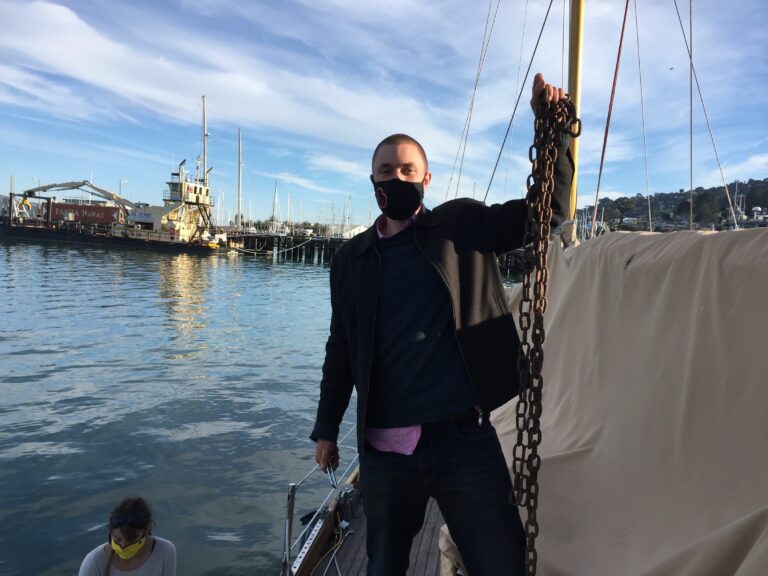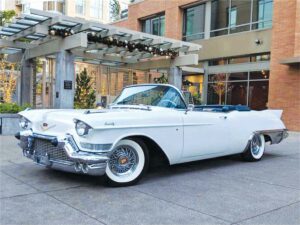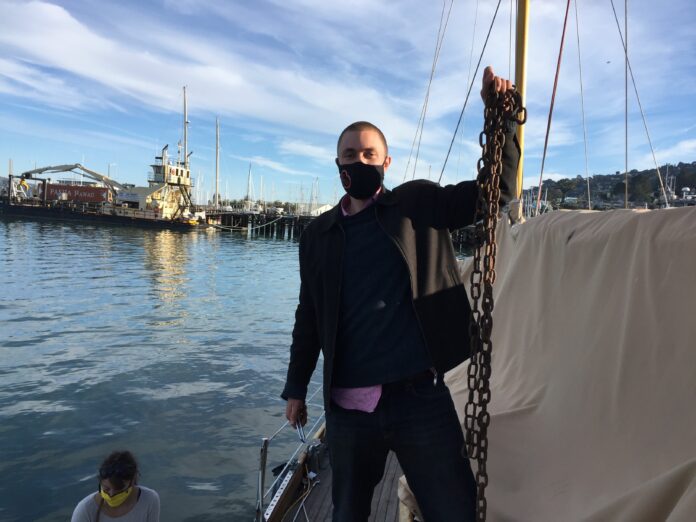The last time I wrote about anchor outs, the people living on their boats in the middle of Richardson Bay, one of them accused me of condoning “domestic terror and genocide on a disenfranchised community.” A lawsuit was even mentioned.
On Wednesday, I found myself on a curious odyssey, seated on a rickety skiff with my accuser, Kim Slater, a petite, pretty brunette with dreadlocks. She rowed me over to board a majestic 42-foot wooden sailboat seized on Tuesday by the Richardson Bay harbormaster.
Though I’m thick-skinned after working for the Pacific Sun for 15 years and wasn’t bothered by her reaction to my article, I was somewhat concerned about joining her for the ride to the sailboat. My worries were unfounded. Slater, 30, actually welcomed me, eager to obtain publicity for the plight of the anchor outs, who are under siege by state and local governments hellbent on keeping people from living on their boats in the middle of Richardson Bay.
Slater dropped me off at the sailboat, christened the Tola Levine, now docked behind the Army Corps of Engineers in Sausalito. An activist took over the vessel on Tuesday, with the owner’s permission, to protest the boat’s confiscation and protect it from destruction.
I talked with Robbie Powelson, 26, the founder of Tamalpais Equity Campaign. Powelson has vowed not to leave the vessel until the anchorage harbormaster releases the boat to its owner, Jim Rohrsson. At night, Powelson chains himself to the boat to prevent authorities from removing him while he sleeps.
“I’m the captain of this boat until Jim gets back,” Powelson said. “We’re going to stay here until we’re sure Jim has a home to come back to.”
Rohrsson, 63, has lived aboard his yawl, a 1962 De Dood International 800, on Richardson Bay since November 2019. Due to a personal emergency and a health issue, he left the boat unattended. Later, it drifted into the channel, according to anchorage harbormaster Curtis Havel, an employee of Richardson Bay Regional Agency (RBRA).
“The boat was at the edge of the channel,” Havel said. “In the channel, honestly. I kept on getting complaints from the Coast Guard and the Army Corps of Engineers. It was a navigational hazard, especially at night time. Unacceptable.”
Havel notified Rohrsson that he would tow the boat if it wasn’t relocated. Unfortunately, Rohrsson, who is receiving treatment for a “major infection” in both eyes, was unable to move the boat from the channel. With the assistance of the Sausalito marine patrol, Havel towed it to the Army Corps of Engineers’ facility.
While Havel assured me that he has no intention of destroying the boat, the act of leaving a boat in the care of the Army Corps of Engineers strikes terror in people living on the anchorage. The Corps typically crushes boats seized by the harbormaster.
The Tola Levine is an exception. Unlike most boats Havel has towed, Rohrsson’s vessel is seaworthy and well maintained.
Still, Havel says Rohrsson and his boat overstayed their welcome in the anchorage. He cites the 72-hour law, which states that vessels may only anchor out in Richardson Bay for three days unless they apply for a permit.
When Rohrsson arrived in the anchorage last November, he was unaware of the 72-hour law until Havel posted a notice on his boat. Rohrsson applied for and was granted a 30-day permit to stay anchored in Richardson Bay. Havel even granted two additional 30-day extensions; however, Rohrsson didn’t leave the anchorage when his permit expired. The harbormaster and the boat owner have spent the last several months at a standoff.
Havel doesn’t trust Rohrsson anymore, because he says the boat owner gave him several different stories about when he would leave and where he plans to go. Rohrsson doesn’t have faith in Havel either.
“I anchored in Sausalito to try to get my financial situation back together,” Rohrsson said. “I got into a war zone. It’s crazy. The harbormaster has been harassing a lot of people out there. I was one of two people that actually applied for and got a permit to anchor out. The end of my last extension was on March 30, right after the COVID lockdown. There was nowhere to go after that.”
I see both sides clearly. Havel’s job is to enforce the law, which means stopping people from living on Richardson Bay. He often travels the anchorage with a social worker who wants to help find housing on shore for the anchor outs. Initially, this sounded like a perfect remedy to me—but many anchor outs don’t seem convinced.
I asked Slater whether she would leave the bay for alternative housing. She didn’t hesitate for a second before she shook her head and told me emphatically that she would not.
“I’ve always wanted to sail,” Slater said. “Ever since I was kid, I was all about the ocean. It’s a lifestyle, a choice, a culture for me. This isn’t just like a free ride. I did a genealogy study and traced my ancestors back to the Mayflower. This is my heritage.”
Unfortunately for Slater and others who refuse to leave the anchorage, a state agency has recently changed its tack.
In recent months, after decades of largely looking the other way, the San Francisco Bay Conservation and Development Commission (BCDC), the state agency governing Richardson Bay, has been pressuring local officials, including Havel, to remove the anchor outs from the estuary. It points to environmental reasons as one basis for the policy.
The anchor outs and activists counter that Chevron, located across the Bay in Richmond, pollutes much more than any other entity on the water. Indeed, the company has been fined by the Environmental Protection Agency for failing to comply with federal environmental laws at its Richmond facilities.
The BCDC claims the anchor outs destroy the eelgrass, subaquatic vegetation, which certain animals rely on for food and habitat. Small fish hide in it, while others lay eggs in it. Fishing birds looking for food also depend on the eelgrass.
“It’s important to protect it,” said David Lewis, executive director of Save the Bay. “Eelgrass is indigenous and there used to be more of it. It’s not an invasive plant. It belongs here.”
The BCDC, believing the eelgrass belongs and the anchor outs do not, refuses to relent on their directive, even with the threat of lockdown again due to Covid-19. They issued their marching orders to the RBRA and the City of Sausalito to rid the anchorage of anyone living on it.
When Havel sees an abandoned, unseaworthy boat, he seizes it and has it destroyed. He says he makes the bay safer for everyone who recreates there.
To the anchor outs, Havel takes boats unlawfully, making folks homeless in the process. They say some of the boats he confiscated weren’t abandoned, rather people left their homes temporarily to visit family or take care of other business.
Many can’t afford a slip in a marina. Some own boats in a state of disrepair that fail to meet a marina’s condition requirements. Even if they could obtain a slip, the applicable state law allows only 10 percent of a marina’s occupants to live aboard their boats. Most Marin marinas are at their limit for live aboards. The anchor outs say they have no option but to leave their boats unattended and anchored in the estuary when they need to go ashore.
Rohrsson’s situation is a bit different. He can afford a slip, as he works three jobs right now: he’s a supervisor at a Peet’s in San Rafael, does assembly work for Home Depot in San Rafael and teaches chess to children in Sausalito and Tiburon. We spoke for about an hour on Wednesday evening and he’s a delightful, if slightly eccentric, man.
“I’m a very focused person and I put out a lot of effort to find a solution,” Rohrsson said. “I recently found a place for my boat at the Vallejo Yacht Club.”
Unfortunately, just before his sailboat was seized, Rohrsson discovered that it has a steering issue. While he’s prepared to make repairs, he first needs to take the boat out of the water, which is costly. The lack of steering means he can’t retrieve his boat from Havel and simply sail away from Sausalito. He needs to tow it somewhere, another expensive proposition.
Havel says it was the worst thing that Rohrsson could have told him. At least at the moment, Havel considers the boat unseaworthy.
“I was hoping Jim would call me today and he hasn’t,” Havel said on Wednesday. “With this stunt by Robbie and the chatter on social media, if Jim doesn’t call me, I might have to put a 30-day notice on the boat that we’ll have to dispose of it.”
“Docking the boat at the Army Corps of Engineers is temporary,” he continued. “With Robbie [Powelson] on the boat, I can’t put it in a slip. Powelson’s actions aren’t helping Jim. He’s making it worse. It becomes a lot more complicated. Powelson is trespassing. He’s on a boat that’s not his and he’s basically on Army Corp property. They don’t want him walking on their property at night.”
The idea that Havel would dispose of Rohrsson’s boat disturbed me. The previous owner of the Tola Levine put in more than $200,000 to restore the classic sailboat and it shows. She’s a beauty.
I think Havel merely used the word “dispose” to motivate me to share the information with Powelson. Havel told me at the beginning of the conversation that he has no intention of destroying the boat and he forwarded me a letter he wrote to Rohrsson stating the same.
Of course, I did tell Powelson, who has no plans to walk on the Army Corps of Engineers’ property at night. He says he won’t step off the boat until Rohrsson returns.
Rohrsson says he’ll be back by Friday. Havel says his boat will be waiting for him, along with a few fines and citations.
The harbormaster will charge him $200 to $300 for towing and approximately $170 for three citations, which include anchoring for longer than 72 hours, being located in the channel, and violating the code that a person cannot live on a vessel in Richardson Bay.
“That code begs the question, why are there so many on Richardson bay?” Havel said. “We’re working on it.”
Rohrsson aims to voluntarily depart from the anchorage, but that still leaves more than 100 boats on the water. Havel says that most of the remaining vessels are unseaworthy; however, the half dozen anchor outs with whom I communicated do not plan to follow Rohrsson into a marina.
The anchor outs and the activists who support them complain frequently about Havel’s mistreatment of the people living on the anchorage. From my vantage point, they’re barking up the wrong tree. The local governments have no control over the issue. Havel simply performs the harbormaster’s duties, sometimes with compassion.
For instance, Havel says he took great care when he towed the Tola Levine, putting the anchor and chain on his own boat to avoid scratching the wooden sailboat and placing extra fenders and adequate line to protect it from hitting the dock at the Army Corps of Engineers’ facility.
It’s the BCDC, not local government agents like the harbormaster, that calls the shots regarding the overall policy. To win the right to live on Richardson Bay, the anchor out community will need to win over state officials. That will require organizing, getting legal advice and contacting state representatives and maybe even the governor, a former Marin County resident.
Whether or not the skirmish over Rohrsson’s boat escalates into a larger policy fight, this is just the latest chapter in a decades-long war for the right to anchor out on Richardson Bay.
In the late 19th century, off the shores of Tiburon Belvedere and Sausalito, well-heeled San Franciscans kept “arks” as summer vacation homes. After people lost their San Francisco homes in the 1906 earthquake and subsequent fire, some relocated to their houseboats year-round. During the first quarter of the 20th century, many of the arks left their floating days behind and moved ashore onto pilings.
The next big change in Richardson Bay came in 1942 after the Japanese bombed Pearl Harbor during World War II. The Marinship Corporation was quickly erected on the Sausalito shore to support the United States’ war efforts. The busy shipyard produced 15 liberty ships and 78 oil tankers, then ceased operations in 1945. (It employed almost 19,000 people during its heyday and the Federal Housing Commission built new housing nearby for 5,500 employees. That housing community still exists today: Marin City.)
Leftover materials from the shipyard were used by returning soldiers, bohemians and artists to build houseboats of all shapes and sizes, most of which stayed tied together along the Sausalito shore. By the 1950s, Sausalito governmental agencies and real estate developers became focused on the houseboats, which they considered eyesores, and the prime real estate they inhabited.
The residents living in the Sausalito hills did not appreciate the funky houseboats interrupting their bay views. The city wanted the houseboats to comply with building codes and stop dumping raw sewage into the Bay. Developers had visions of building in the desirable area. Orders were issued to remove the boats; lawsuits were filed in response and tensions grew high.
In 1971, the Houseboat Wars fully erupted after the Marin County Sheriff’s Office attempted to tow away several houseboats. They were met by a small army of houseboat owners defending their property. The owners won that round.
Finally, during the late 1970s, a deal was struck. Marinas with permanent berths were built and many of the houseboats moved to those harbors. Some boats, however, moved further out into Richardson Bay, joining a couple of dozen other liveaboards that began quietly anchoring there in the 1960s.
The BCDC made little effort to curtail the growing population until 2015 when the agency expanded its enforcement department and stepped up its efforts. They initiated a full court press in 2019, after the state auditor released a report stating the BCDC’s “failure to perform key responsibilities has allowed ongoing harm to the San Francisco Bay.”
“For them to tell me I can’t live here, what’s next?” Slater said. “They want us to give up all our civil liberties it seems.”
Not at all, according to the BCDC. It’s not a right to live in Richardson Bay.
Rohrsson, who once worked as a mediator at a community resolution center in Ithaca, New York, believes there are multiple potential remedies to the anchor out situation. Legalizing permanent mooring in Richardson Bay is one.
“I’ve asked a lot of questions, but I’ve gotten very few answers,” Rohrsson said. “Why can’t we come together and come up with a solution?”


























